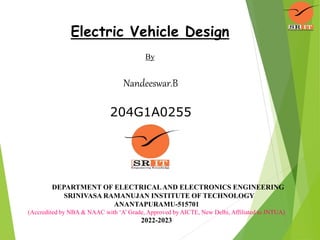
Internship ppt format (1) (1).pptx
- 1. Electric Vehicle Design By Nandeeswar.B 204G1A0255 DEPARTMENT OF ELECTRICALAND ELECTRONICS ENGINEERING SRINIVASA RAMANUJAN INSTITUTE OF TECHNOLOGY ANANTAPURAMU-515701 (Accredited by NBA & NAAC with ‘A’ Grade, Approved by AICTE, New Delhi, Affiliated to JNTUA) 2022-2023
- 2. CONTENTS Certificate Introduction Description Learning Outcomes Conclusion
- 4. Introduction to EV Key Parts of EV Benefits of Electric Vehicles MATLAB MODULES -Battery -Motors -Mechanical parts in MATLAB EV Demo Agenda :-
- 5. • An electric car is an alternative fuel automobile that uses electric motors and motor controllers for propulsion, in place of more common propulsion methods such as the internal combustion engine (ICE). • Electric cars are specifically a variety of electric vehicle intended for use as a road-going automobile. Electric cars are commonly powered by on-board battery packs, and as such are battery electric vehicles (BEVS). • Electric cars currently enjoy relative popularity in countries around the world for their eco-friendly nature.
- 6. Key Parts of EV :-
- 8. Kea Parts of Electrical vehicle Traction battery packDC-DC ConverterElectric motorPower inverterCharge PortOnboard chargerControllerAuxiliary batteriesThermalsystem (cooling) Transmission
- 9. 1.Traction battery pack It powers the electric motors of an electric vehicle. The battery acts as an electrical storage system. It stores energy in the form DC current. The range will be higher with increasing kW of the battery. The life and operation of the battery depends on its design. The lifetime of a traction battery pack is estimated to be 200,000 miles.
- 10. 2. DC-DC Converter The traction battery pack delivers a constant voltage. But different components of the vehicle has different. requirements The DC-DC convertor distributes the output power that is coming from the battery to a required level. It also provides the voltage required to charge the auxiliary battery.
- 11. 3.Electric motor o Electric traction motor is the main components of electric vehicle. o The motor converts the electrical energy into kinetic energy. o This energy rotates the wheels. Electric motor is the main component that differentiates an electric car from conventional cars. o An important feature of an electric motor is the regenerative braking mechanism. o This mechanism slows down the vehicle by converting its kinetic energy into another form, and storing it for future use. There are basically two types of motors DC and AC motors.
- 12. • 4.Power Inverter • It coverts DC power from the batteries to AC power. • It also converts the AC current generated during regenerative braking into DC current. • This is further used to recharge the batteries. • The inverter can change the speed of the vehicle. 5. Charge PortThe charge • port connects the electric vehicle to an external supply. • It charges the battery pack. • The charge port is sometimes located in the front or rear part of the vehicle
- 13. 6.Onboard charger Onboard charger is used to convert the AC supply received from the charge port to DC supply. The on board charger is located and installed inside the car. It monitors various battery characteristics and controls the current flowing inside the battery pack. 7.Controller Power electronics controller determines the working of an electric car. It performs the regulation of electrical energy from the batteries to the electric motors. The pedal set by the driver determines the speed of the car and frequency of variation of voltage that is input to the motor. It also controls the torque produced.
- 14. • 8.Auxiliary batteries Auxiliary batteries are the source of electrical energy for the accessories in electric vehicles. In the absence of the main battery, the auxiliary batteries will continue to charge the car. It prevents the voltage drop, produced during engine start from affecting the electrical system. 9. Thermal system(cooling) • thermal management system is responsible for maintaining an operating temperature for the main components of an electric vehicle such as, electric motor, controller etc. It functions during charging as well to obtain maximum performance. It uses a combination of thermoelectric cooling, forced air cooling, and liquid cooling.
- 15. 10. Transmission It is used to transfer the mechanical power from the electric motor to the wheels, through a gearbox. The advantage of electric cars is that they do not require multi-speed transmissions. The transmission efficiency should be high to avoid power loss.
- 16. Lower running costs Low maintenance cost Zero Tailpipe Emissions Tax and financial benefits Petrol and diesel use is destroying our planet Electric Vehicles are easy to drive and quiet Convenience of charging at home No noise pollution
- 17. All the students are instructed to prepare the PPT slides in the order mentioned in Contents NOTE: You have to complete presentation with in 5 minutes